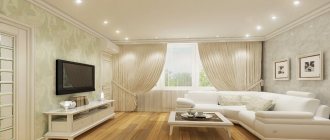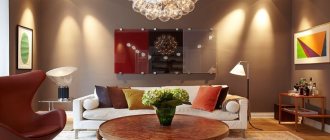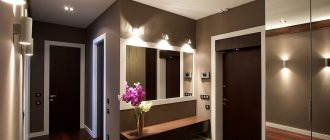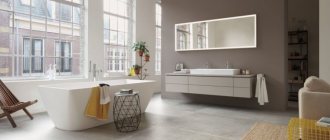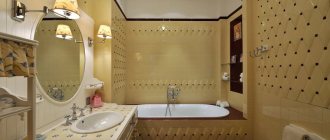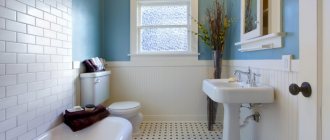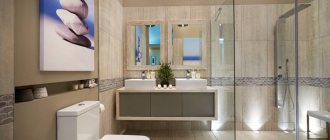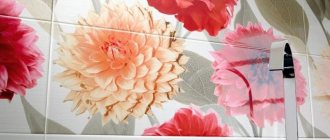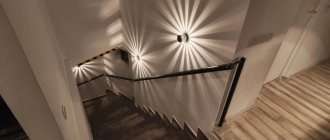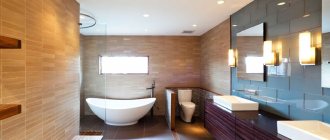Lighting system planning and design
Do not forget that the bathroom is not only intended for relaxation and relaxation, necessary after difficult and busy work days.
Here, all family members are preparing for the coming day and getting themselves in order before work or school, ladies are applying makeup or washing it off, so it is important to choose the right lighting for the ceiling in the bathroom and other surfaces.
Harmonious design involves timely and preliminary design of the decor and finishing of all surfaces, which makes the arrangement of the room as practical as possible.
Before designing a lighting system, it is necessary to carry out zoning and division of space, and consider the placement of plumbing fixtures and furniture.
How much light do you need in the bathroom?
The ideal option for a bathroom is a sufficient amount of light, close to daylight. This way you can create the most natural light possible for a natural look and makeup application. Since a combined bathroom can be used for different needs, it is better to install a combined type of lighting in it.
For a small bathroom in a Khrushchev-era building, one central light in combination with two or three additional wall lamps is appropriate.
In a large room, it is advisable to install several overhead lighting devices. The greater the number of lamps, the smaller in size and power they should differ. For a spacious bathroom, zone lighting is suitable, thanks to which it will be possible to highlight individual functional areas, as well as emphasize the configuration of the space.
The photo shows the lighting of a small bathroom in the form of a laconic central chandelier placed on the ceiling
The following important factors influence the choice of lighting:
- Interior style and color palette. The darker the shade of the walls, the greater the intensity of the light sources.
- Size and shape of the bathroom.
- Features of zoning.
- Types of lamps, their maximum power and mounting method.
- The presence of reflective surfaces in the form of mirrors, tiles, etc.
First of all, before starting renovations in a room, they think through the light system and the specific places where its sources will be placed. They provide for cable wiring, construction of plasterboard false beams and other things.
Which light to choose?
Regardless of whether the bathroom is windowless or not, you should choose bright lighting that will not irritate the eyes. Warm light with a yellowish tint is considered the most comfortable and pleasant. This soft glow will promote complete relaxation in the bathing area. Devices with cool bluish light, located near the washbasin, will help you quickly wake up and invigorate.
What types of lamps are there - advantages and disadvantages
| Type of lamps | pros | Minuses |
| Incandescent lamps | Cheap. Gives soft light. Turns on quickly. | They are heating up. Not suitable for installation in suspended ceilings. They burn out quickly. Not economical. |
| Halogen | High light output. Long service life. Can be used for spotlights in suspended ceilings. Available in two versions: 220V and 12V. | Connected via stabilizer. They deteriorate from touching the skin. They are warming themselves. Often the base burns out from the light bulb. |
| Luminescent | Economical. Choice of color shades of emitted light. Two contact options - rods and base. Smooth diffused light flux. | Sensitivity to low temperature. Presence of mercury vapor in the flask. You can't break it. |
| LED | Repairable. If one diode burns out, the cluster can be repaired and the lamp will continue to work. Economical. Durable. Wide variety of colors. Possibility of programming. Not afraid of frequent switching on/off. | Expensive. Switching power supplies are required. Without them, lamps quickly fail. Instead of the stated 11 years, after 3 years the crystals lose their brightness and begin to fade. For comfortable work, diffuser shades are required. |
Methods of mounting lamps
When choosing suitable lamps, focus not only on the designer’s intentions and the cost of the product, but also on their technical parameters.
Based on the method of fastening, they are divided into the following groups:
- Built-in. Spots and spotlights are mounted in a suspended ceiling using special lugs. For incandescent lamps the ceiling gap is 12 cm, and for halogen lamps it is approximately 7 cm.
- Hanging. For such models, you need a metal hook that is well secured to the main ceiling. As a rule, they are very decorative.
- Invoices. These are compact and lightweight devices, most often having the correct shape. For example, ceiling lamps. They are equipped with a base with special holes for installation using hardware.
Lamps can be very different, but their elegance does not depend on size, so even a small bathroom can be illuminated and decorated at the same time.
Design techniques in organizing lighting
Human imagination knows no boundaries, so the ideas produced by the minds of professional designers are diverse, enchanting and non-standard.
Our task is to choose your option from all the variety offered. The one that will best suit both our premises and our own needs.
It is not at all necessary for the bathroom to shine with sterile whiteness: the only important thing is that all the objects placed in this space harmoniously complement each other
We will proceed from the fact that a room of any size can be transformed if you are guided not only by a sense of beauty, but also by common sense. A harmonious combination of lamps of different types, located at different lighting levels, should provide this intimate corner of your apartment with its special appeal.
Technique #1 - proper organization of ceiling light
Any bathroom should have overhead light. The most daring design solutions still involve the use of lamps, if not on the ceiling itself, then at a level of 180 cm from the floor and above.
The composition “starry sky” receives increased attention from buyers. But magnificent crystal chandeliers also have their fans.
It is interesting that a massive chandelier made of colored crystal does not look like an alien body at all in this Provence style interior
Spotlights win their fans with their variety of designs, reliability and, of course, efficiency. They are easy to use; you just need to think carefully about their placement scheme in advance. You can place them around the perimeter, concentrate them in the central part or above functional areas (bathtub, washbasin, mirror, etc.). It is important not to leave shaded areas in the room.
You can achieve uniform distribution of light even in a very spacious room if you use a large number of low-power sources of modest size.
Often, to implement such tasks, halogen lamps of built-in or open type are used. Built-in structures will look great if they are mounted in a suspended ceiling.
The combination of direct and reflected light creates a fabulous picture that you want to admire while lying in a cozy bath filled with warm water
When the ceiling in your bathroom is high enough, it makes sense to use not only direct, but also reflected light. To do this, for example, at a short distance from the ceiling, you can install an aluminum suspension with point devices that provide direct beams directed downwards. The reflected ones will be emitted by sources mounted on the opposite side of the suspension.
Busbar and string conductive systems can help organize unusual lighting for a room designed in a futuristic style. They are perfect for a room with a low ceiling. It is to it or to the top of the walls that such unique light “beads” are attached.
Technique #2 - emphasis on the main element of the interior
Since the main elements of most bathrooms are the sanitary ware of the same name, it should not be deprived of light accents.
The idea of installing a bathing bowl on a pedestal is not new: it has long found its fans. In a spacious room, this design not only looks attractive, but also allows you to decorate the pedestal itself with individual decorative elements and, of course, lighting around the entire perimeter. Candles mounted on a pedestal in one place or around the font will also find their use here.
The sides of the pedestal can serve as a source of lighting and a stand for candles, towels, pumice, cream, scrub and aromatic oils
The bowl itself can be illuminated with an elegant ceiling chandelier or even a simple lampshade if the bathing area is separated from the main space of the room by a curtain.
Bright lighting allows you to use all the functionality of the bathtub, and its LED lighting will create the illusion of flowing water or a container floating above the floor surface.
This self-illuminated bowl captivates with its inner glow, but can also be brightly illuminated with the help of a chandelier made in the form of air bubbles
An autonomous lighting can be hidden in the tank itself, allowing the recipient of water procedures to feel ascended to heaven or immersed in the depths of the ocean.
This option is ideal for those who are not used to saving money and do not want to burden themselves with thoughts about how to install additional lighting.
Probably, even colored streams of water would not look as impressive as this light pouring from a shower head, captured in a monochrome photograph
Interesting ideas can be realized even if the traditional font gives way to a modern shower. The illumination of the shower head looks especially impressive when the light source is mounted directly into it. The stream of water may take on an unusual color.
Technique #3 - successful lighting of the mirror area
Regardless of the size of the room, there must be a mirror in it - the basis of the working area. It is usually located above the washbasin and next to the shelves for cosmetics and personal care products. Designers offer different ways to highlight and decorate this corner of the room.
When choosing the appropriate lighting option for the mirror area, rely on three basic rules:
- the light should not blind the eyes and be reflected in the mirror in the form of glare;
- No shadows should fall on your face;
- The color scheme of lighting should match the natural one as much as possible.
Existing room lighting options
It is important to remember that lighting a bathtub with a suspended ceiling or suspended plastic structure has its own characteristics in terms of design and installation.
When considering all options, it is necessary to take into account the architectural features of the room, the safety of wiring and utilities, and focus on the following types of lighting:
- ceiling chandeliers and lamps;
- spot lighting around the perimeter;
- special lighting of individual zones.
Light zoning allows you to harmonize the environment as much as possible and add zest to the design and interior solution.
To do this, you need to calculate the system and worry in advance about purchasing consumables and cables, think about their insulation and stock up on lighting fixtures and switches.
Ceiling lighting
Practical lighting for a small bath can be achieved through the use of ceiling lights that provide enough artificial light. These devices are distinguished by a rich variety of design solutions and are real works of art, corresponding to different stylistic trends in the interior.
To arrange such lighting, you can choose two paired lamps, one will be used as the main source and mounted at the entrance, the other - above the bathroom or directly above the mirror.
Spot lighting
When choosing what kind of lighting is needed for the bathroom, it is necessary to proceed from the practical characteristics of the room itself and the finishing materials used.
For panel and stretch coverings, the ideal solution is the use of spotlights that are installed on different surfaces and provide the necessary lighting intensity.
A lot of small and bright lights are easy to use in creating a design composition, for light zoning of a room and to complement the interior concept.
Special lighting
Full LED bathroom lighting is achieved by selecting and using small wall lamps or designer sconces. Often, such paired products are mounted in close proximity to mirrors or work surfaces; they can often be found next to the bathroom.
Such practical devices provide sufficient light flux for special hygiene and cosmetic procedures and are especially popular in the minds of modern interiors.
Combined lighting
The bathroom spot lighting used can be supplemented with LED lighting, which can be used independently as a separate light source.
You can combine different lamps and lighting devices, creating original and sophisticated compositions, emphasizing and placing accents in the arrangement of the room and its decor.
The main thing is not to overdo it and preserve the originality of the room and its intended purpose, making it as cozy and comfortable as possible due to high-quality and not bright lighting.
It is important to take into account when choosing a lighting system for the bathroom the possibility of arranging additional or natural lighting through a saved window or building a false analogue. An interesting design move would be illumination of mirror surfaces or accessories.
Protection requirements
There are increased requirements for the protection of lighting devices intended for installation in rooms with high humidity from moisture and dust. The marking of such lamps necessarily contains 2 important characteristics: IP index and an indication of compliance with a certain humidity zone. Let's talk about them in more detail.
Protection indices
The level of dust and moisture protection is indicated by the IP index, followed by two numbers, for example, 65. The first number six corresponds to the dust protection class, 2 informs about the protection class the device has from water.
Dust protection classes
Moisture protection levels
High humidity areas
To simplify the task of choosing a moisture-resistant lamp, a classification of degrees of protection was created according to areas of rooms with high humidity. The humidity zone index on the packaging or in the luminaire passport sets the framework within which the lighting device can be used:
- IP68 - a lamp with this marking can be immersed in water and used in any conditions;
- IP67 - the device is completely sealed, it can be used in absolute humidity;
- IP44 - the device is resistant to intense fumes, accidental ingress of jets and flying splashes; .
- IP24 - luminaire with condensation protection, can be installed above the sink.
Lamps with an index less than IP23 are intended for close placement near wet areas, but still not inside them.
Many modern models of moisture-resistant lamps are marked with three numbers, the last of which indicates the degree of impact resistance of the device. This indicator is not of great importance if during future operation the lighting device is not intended to be systematically subjected to intense mechanical stress.
Lighting of functional areas
Each area of the room requires the organization of auxiliary light. In this way, you can not only visually change the perception of space, but also add a touch of originality to the monotonous atmosphere.
Work zone
This area with a mirror and washbasin requires high-quality lighting, which should fall evenly on both sides. For this, it is best to install two side lamps with a symmetrical arrangement, slightly higher than eye level. This option is especially appropriate when applying makeup, as it provides the desired brightness and does not create shadows on the face. For shaving, one lighting fixture above the mirror will be enough.
Lamps with flexible brackets with the ability to adjust the direction of light are considered especially convenient.
The photo shows a work area in the bathroom, decorated with a mirror with built-in side lights.
Bath and shower
For lovers of relaxing baths, installing one or two devices with a muted, diffused glow is suitable. Using LED lighting, you can also decorate the bath itself around the perimeter or, if there is insufficient lighting, place several lamps in the shower area. The best option for a humidity zone would be devices with the ability to change the brightness and direction of the light flux.
The photo shows spotlights located above the bathtub in the interior of the bathroom.
Storage systems and technology
To create an extraordinary romantic mood and give the environment a certain elegance, highlight individual elements of the interior with light. This decorative solution allows you to highlight shelves, cabinets, drawers and other items. Such illumination can be carried out using LED strip or spotlights. As additional lighting in the room, an area with towel hooks or a place where the washing machine is located is equipped with a separate source.
The photo shows shelves in the bathroom equipped with spotlights.
Mirror and washbasin lighting
A classic technique in this area is installing sconces. Devices on the market are presented in different styles: classic, modern. The light of the lamps should be soft and diffused. In order to clearly see the reflection, a point light is more suitable.
The advantages of sconces include simple installation and operation. The lamps in them are easy to change. If necessary, the lamp can be moved. One of the disadvantages is the relatively large size. Devices visually reduce space and distort proportions.
Mirrors with built-in lighting save space and look modern and original. However, unlike removable decor, which is easy to remove or move, such lamps in the mirror cannot be dismantled.
External lamps are also small in size, and, as a rule, are installed in groups of 2-4 pieces at the sides. Manufacturers usually install them vertically or horizontally. Such devices are suitable for any bathroom interior.
Levels of placement of lighting devices
Proper organization of light in the bathroom should meet the different needs of users. The basic principle that should be followed when placing lamps is this: the light should be bright enough, but not blinding or intrusive. Modern designers suggest paying attention to combined lighting.
The bathroom ceiling lighting is pleasantly complemented by lamps located in the work area around the mirror, on the walls and behind the window imitation
To implement such an idea, devices need to be placed at different levels.
Depending on the level, lighting can be:
- Top (ceiling). The lamps are fixed to the ceiling itself or directly below it. If the bathroom does not please the owner with its size, then perhaps it makes sense to limit it to one lampshade, which is traditionally mounted either in the center of the ceiling or directly above the doorway. A spacious room is decorated with a whole constellation of spotlights or even a chandelier. More information about bathroom ceiling lights can be found here.
- Workers. A soft and diffused flow of light can be provided by an LED strip under the washbasin and around the mirror. Shelves with cosmetics and detergents, washbasin, etc. can be illuminated from below and with other types of lamps. Light sources on flexible brackets, placed on both sides of the mirror, allow you to change the degree of illumination and eliminate unnecessary shadows.
- Nizhny. This type of lighting is rarely functional. It is usually purely decorative and is widely used as interior decoration and aids in relaxation. In this case, light sources are located under individual elements of the interior, for example, under the sides of a bathtub, at floor level or a decimeter from its surface.
Simultaneous or sequential switching on of lighting fixtures mounted at different levels allows you to create an atmosphere in the room that optimally matches the user’s mood and the tasks that he has to solve.
An active lower level of lighting, built into the bathroom flooring, creates a special romantic mood and colors the room with mother-of-pearl.
Installation
The material of the ceiling covering in most cases becomes the determining criterion for choosing a lamp. If there is no overlay trim and the ceiling is a painted concrete slab, an overlay model in the form of a plate with a matte shade is best suited.
The lighting in a small bathroom will be quite intense if the lighting device is designed for two LED bulbs with a power of 7 W each.
It is installed as follows:
- Using a drill or hammer drill, holes are made in the concrete for self-tapping screws.
- The metal base of the lamp is applied to them and screwed to the base with self-tapping screws.
- The electricity in the house is completely switched off using an automatic machine.
- The electrical wire is connected to the lampshade.
- Light bulbs are screwed in.
- The lampshade snaps into place.
- The electricity is turned on and the operation of the device is checked.
- It will be more difficult to attach lighting equipment to a plasterboard base.
- If multi-level light is installed in the bathroom, the design of the room will only benefit from this. But realizing such an idea is not so easy.
First, a lighting design plan is drawn up, then according to it, the location of the light bulbs is marked. Double-insulated wires are led to it; they are laid along a metal profile, with the help of which a frame is formed for installing drywall.
The wires are secured with ties. Before installation, holes are drilled on a sheet of plasterboard for ceiling lights of the required diameter. After attaching the sheet, wires are threaded through them, which are then stripped and connected to the terminals of the lampshade. At the final stage, a light bulb is inserted into the lamp.
The lighting of the toilet is done in the same way if plasterboard is used as a ceiling finish.
It is even more difficult to install lamps on a stretch ceiling film. Carrying out such a procedure requires professional skills and the ability to make accurate calculations.
Without going into details, the installation of lighting equipment is carried out as follows:
- First, the frame of the lighting fixture is attached to the concrete base.
- Then the suspended ceiling is installed.
- Afterwards, holes are formed in the film.
- It is connected to the frame of the device using special insulating rings (they prevent possible rupture of the film).
- At the final stage, the light bulbs are inserted into the frame.
Note! To ensure that the canvas lasts longer and does not turn yellow when heated by lighting fixtures, you need to choose LEDs with a base for lighting the bathroom.
They do not heat up, which means that the film next to them will not lose its physical properties.
Top or ceiling level lighting
In small bathrooms, they usually make do with one lamp. It is quite enough for lighting. And if the room is larger, then it is better to install several pieces to distribute the light evenly. One is above the bathtub and the other is by the door.
Using small lamps with halogen lamps, you can create multi-position lighting (“starry sky”).
Lighting fixtures can be of different shapes: round or oval. It is important that they complement the design of the room.
Medium or working light level
The most important thing about medium lighting levels is to highlight important work areas. Usually this is a washbasin and a mirror. Install two lamps symmetrically on both sides at the top of the mirror. If it is small, then choose smaller lamps too.
This will create bright lighting that will not dazzle your eyes or create unnecessary shadows. It is important that the lighting devices are not reflected in the mirror, then your face will be clearly visible.
A great idea for a bathroom is lighting around the perimeter of the mirror. Strip LEDs, which are especially popular now, are suitable for these purposes. It is not advisable to install colored lampshades in this area.
If you have enough space for furniture in your bathroom, you can use lighting for it.
Build small light bulbs into doors, cabinets, and countertops. This will create the necessary accents in the room, elegance and a romantic mood.
Nowadays it is fashionable to illuminate the bathtub. It creates the necessary relaxing mood. But this option is not cheap and not everyone can afford it.
Don't be upset if you can't afford it. To create a more private atmosphere, sconces are also suitable. Choose one with a colored glass lampshade. Install it on the side of the bathtub, but not above it, for safety reasons.
- For a spacious bathroom, but with a slightly high ceiling, you can install a high floor lamp. This way the light will fall beautifully on the water.
- Swivel lights are also very good for mid-zone lighting. You can adjust the direction of the light yourself, where it is convenient for you.
Floor level lighting
Floor lighting is optional but not required. Its use creates a special magical atmosphere.
If you still decide to use it, then choose closed floor portholes (flashlights). Translucent lamps are also suitable for these purposes. Alternatively, you can use aromatherapy candles.
Types of lamps and selection criteria
The quality of lighting depends not only on the proper placement of lamps, but also on the power of the lamps. Typically, one suitable main device is selected, which is complemented by several auxiliary ones. This model is also suitable for suspended ceiling coverings.
Overhead lighting in the bathroom does not exclude the possibility of using combinations. For example, a regular ceiling lamp, complemented by spotlights.
Depending on certain factors, there are several types of lamps:
- According to the purpose of use. Here we are talking about additional decorative lighting, or general, working, main lighting. In each case, the location of the devices is selected separately.
- By type of lamps. We can distinguish metal halide, LED, fluorescent, incandescent, and halogen lamps.
- By location. The presence of protrusions above the surface allows us to talk about working with types of closed or open devices.
- Based on work areas. Lamps can be found above the bathroom or in cabinets, near mirrors or doors.
Related article: Apartment lighting: organization, placement options and new ideas |
+90 photos Different types of bathroom fixtures It is advisable to calculate the load from the electrical network in the bathroom at the planning stage. It is recommended to install a separate machine on the branch due to the presence of high humidity. Then the network will receive additional protection from short circuits, and fewer problems arise when organizing it.
Incandescent lamp
Simple operation along with affordable prices have made such products very popular. When turned on, the light bulb lights up immediately, which makes it especially functional. The performance of the product is practically independent of the ambient temperature.
But there are also a number of disadvantages. For example, a low level of luminous flux along with a short service life of only 100 hours. The bulbs become very hot, making them impossible to use under some circumstances.
It is not allowed to install an incandescent lamp in a lamp with a small lampshade, with a variety of shades made of plastic or textile-based products.
It is not advisable to place an incandescent lamp in such a lamp.
Halogen varieties
Such lamps are often used in so-called spots. The main advantages are long service life, high luminous efficiency. It is assumed that an aluminum diffuser will be used, for which thermal radiation will not be a problem, making it possible to use it in spotlights, regardless of the surface on which they are mounted.
The power of such lamps is in the range of 12-50 W. In the first case, additional installation of a low-voltage transformer will be required.
What are the benefits of luminescent types?
Luminous flux and service life are even longer than previous models. It is assumed that different types of phosphor will be used, which are responsible for creating different shades. For example, with such products the light can be cold natural, warm white, daylight, and so on.
Models in the form of tubes can be used as independent light sources. This design has a drawback only in the sense that it actively reacts when the temperature and pressure drop, after which the product stops igniting. The operation of the light bulbs is by no means silent. Characteristically, there is a limiting power of up to 150 W.
LED backlight
Manufacturers say that LEDs can last up to 100 thousand hours in total, while they are a small amount of energy whose consumption is active. Most often, lamps of this type are complemented by spotlights located on an area of 1 square meter and are used to create special lighting strips. Even thin glass will not be harmed by them.
Calculation of the optimal power indicator
The level of illumination largely determines how comfortable it will be to be in a particular room. After all, this indicator can even affect not only our nervous system, but also vision. Therefore, corresponding standards were created, which indicate how many lumens should be used per square meter. This will allow you to understand which models illuminate the rooms how.
But when purchasing, many pay more attention to the energy consumed, which is measured in Watts. The brightness of light under specific circumstances is determined precisely by lumens. This determines how the bathroom interior will look.
200 lumens per square will be enough for most bathrooms:
- With 40-80 W LEDs you need 6 thousand lumens.
- 40 W fluorescent lamps require 2000 lm, 200 W - only 1500.
- Halogen lamps at 230 Volts and 42 W suggest the use of 625 lm. If the power is 70 W, then you will need to apply 1500 lm. This must be kept in mind during repairs.
- In the case of conventional incandescent lamps, 200 lm is enough. At 100 W you need 1350 lm.
Article on the topic: Chandeliers in the interior of different styles: help in choosing (+130 photos)
Correct places to install lamps
There are always not enough light streams. Therefore, the ideal option is when the entire system has three levels:
- The upper level is a ceiling light in the bathroom. Usually they mean a chandelier that is mounted in the middle of the ceiling. But, if the room is small, it is recommended to give preference to spot options. For example, in the form of several small lampshades evenly spaced on the ceiling, or along a common perimeter.
- Bathroom lighting for work areas. Involves providing illumination for areas of primary importance. Here, sconces are usually used together with lamps; they are often located near mirrors, sinks and shower stalls. To illuminate the working parts of the space, the brightness of the light is important.
- Downlighting in the bathroom. There are more decorative elements than functional ones. Designs are needed to decorate any part of the room. Various types of lighting are used, but most often LED.
Types of lamps and methods of mounting them
The widest range of lighting equipment is available on the market, which allows everyone to choose the ideal option that suits exactly in a particular case. Design concept, technical parameters and installation method - this is what you should rely on when choosing.
The fastening method allows us to distinguish three types of design:
- Built-in. These are the so-called “spots”, spotlights. In a small bathroom they easily serve as main or additional lighting. Installation involves the use of special lugs and is carried out at the base of suspended ceilings. The main thing is that the interceiling cavity does not exceed 12 centimeters in the case of incandescent lamps, and 7 centimeters for halogen lamps.
- Hanging. It is assumed that multi-arm chandeliers or single-lamp lamps are hung directly on a metal hook in the ceiling. It is only necessary to correctly select the power of the main lamps so that the light fluxes do not irritate.
- Invoices. Many ceiling lamps are like this. They are suitable for any surface that serves as a base in a particular room. They can be made the main or additional light source. The structures are equipped with tips made of metal or plastic. Installation is carried out using hardware. Devices are most often produced with the correct shapes preserved, which is easy to see in the photo.
On video: tips for choosing bathroom fixtures.
Lighting in a bathroom with a suspended ceiling
What you need to know before choosing bathroom lighting on a suspended ceiling:
- In the bathroom, PVC sheets are most often used. It is not advisable to install fabric sheets if they are porous. The film can withstand 12-volt halogen and LED spots. The heating of these lamps is insignificant, so they do not cause stretching of the coating.
- The lighting system must be connected to a transformer or power supply of sufficient power to provide power to all spots.
- Fluorescent lamps do not tolerate high humidity.
- It is not advisable to use models with an incandescent filament, because they get very hot and lead to deformation of the canvas. If there is a strong desire, then it is allowed to use them for chandeliers and sconces located no closer than 30 cm from the ceiling surface.
How to visually expand a bathroom
Helpful information:
- Calculation of room illumination
- Is it possible to use liquid wallpaper for the bathroom?
- Children's room design for a girl
- How to choose tiles for the bathroom. Lots of photos.
- How to find out the area of a room
- DIY installation of PVC panels in the bathroom
You can make your small bathroom look a little bigger. To do this, designers use several clever techniques with which the space noticeably expands. Properly selected finishing materials, as well as the placement of all interior details, will play a huge role in this. These small tricks will create some illusion of more space.
You should not use dark colors to decorate your bathroom. This immediately visually reduces the size of the bathroom. Any dark colors hide the volume of the room.
In small rooms, to visually increase the space, you can combine color combinations to decorate the walls. When you make one wall in a red tone, then the other can be made in white or milky tones. Only this technique will visually increase the space.
How to calculate the ceiling height in a house or apartment
Ideas in various interior styles
In the classic style, the furnishings are decorated with steel or forged bronze candelabra and crystal products with numerous pendants, chains, beads and other decorative elements are used.
For minimalism, it is appropriate to use pendant lamps that have a simple shape and lack of decor. In the interior there are often models with round shades in the form of balls, cones or abstract lamps.
Provence is characterized by floor lamps, volumetric chandeliers and metal or wooden candelabra. To complement the beautiful interior composition, massive forged chandeliers with glass lampshades are selected and lamps or sconces in the shape of inflorescences are placed near the mirror.
The photo shows a lighting option for a bathroom decorated in a modern style.
LED lighting in combination with metal halogen lamps fits perfectly into the loft style. To enhance the industrial atmosphere, use pendant lamps on thick chains or cords that resemble wires.
Scandinavian interiors include any type of wall or ceiling lamps that can be combined with modern LED lamps. This style does not accept overly bulky and pretentious light sources.
Photos of bathroom fixtures
Read here! LED lamps: detailed description, application features and review of the best manufacturers
